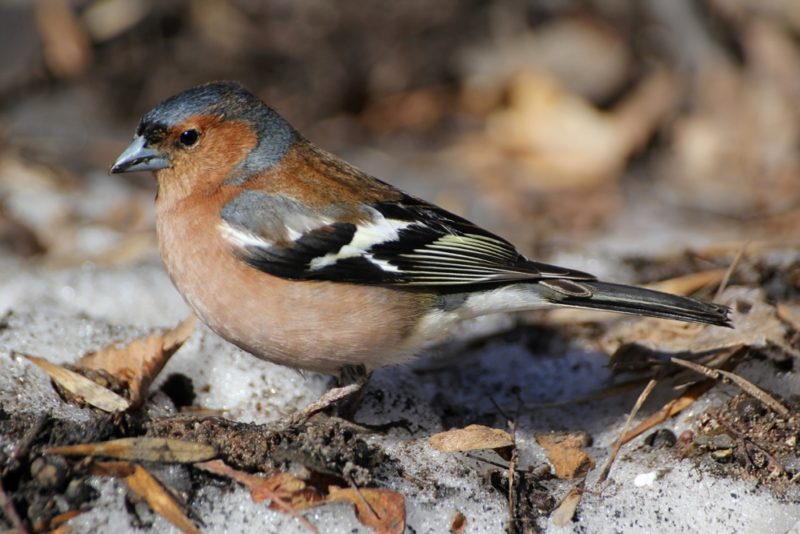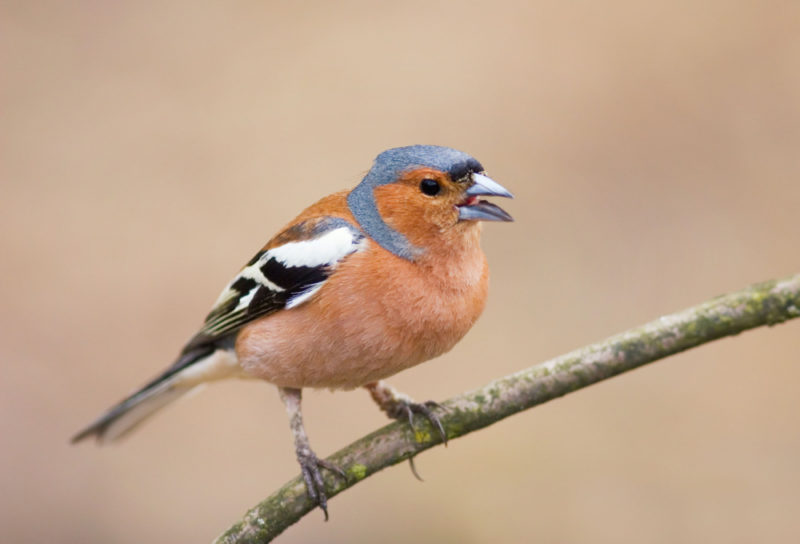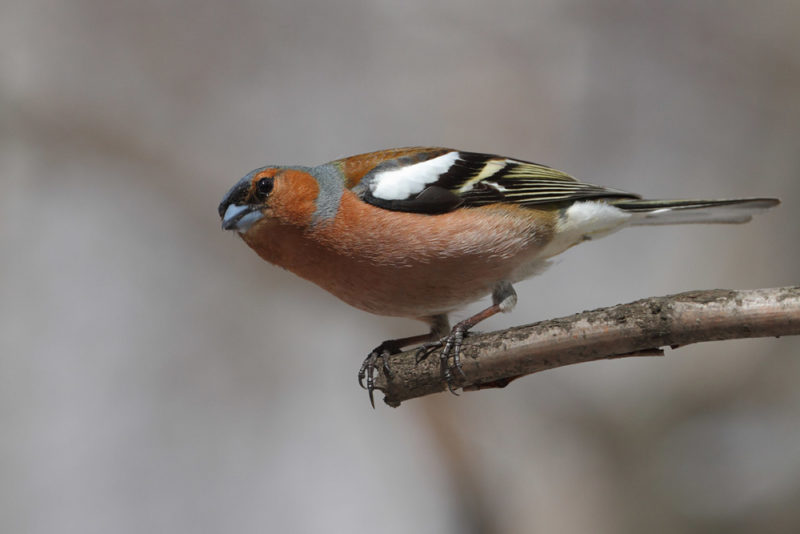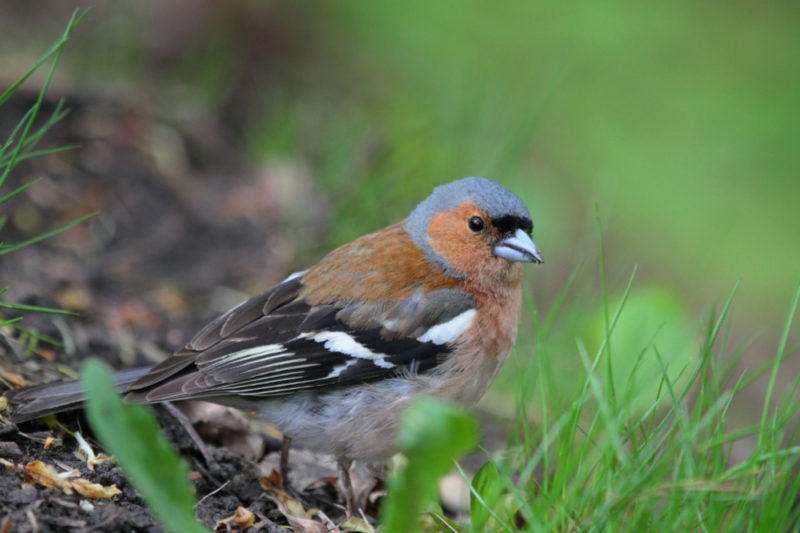The voice of this bird can be heard in good weather since the end of February. The common finch often lives near a person’s dwelling, but prefers to sing its songs high on the branches. People say that a bird is able to predict weather changes, giving a signal before the rain.
Material Content:
Description and features of common finch
The scientific name Fringilla coelebs was given to the bird of the family finch by the taxonomy father C. Linney back in 1758. The body length of adults of this species is 14–16 cm, weight is from 15 to 35 g, wingspan is up to 28 cm. The beak has a conical shape.
A finch bird is the size of a sparrow. Sexual dimorphism is pronounced. Males are larger than females, in spring in mating plumage they look most colorful, which is easy to see in the photo.
Male Description:
- The head is covered with a blue-gray “hat”, the forehead is black, the cheeks, throat and chest are brown-red or brownish-pink.
- The beak is bluish or steel in color with a dark tip, brightens in winter.
- The back is gray-brown, the green tart.
- The wings are dark gray and black with white stripes of various lengths and shapes.
The color of the female is more modest, because it is the female who has to hatch the chicks among the branches of a tree or a tall shrub.
Plumage with a predominance of brown-gray and pale brown shades is a good disguise for a small bird. Beak is light brown. On the wings and along the edge of the tail are white stripes. The color of young animals of both sexes is the same as that of females. Only on the head there is a lighter spot.
Character and lifestyle
The finch spends a lot of time on the ground in search of food. The bird walks quickly, moves in short and long jumps.At the same time he turns his head, nods, makes short sounds, pecks insects and seeds.
Finches nest in forests, prefer habitats with alternating deciduous and coniferous trees, shrubs, wet river banks, foothills with diverse vegetation. Found in spruce forests along with crested titmouse. Finches have enough food and places to build nests in parks, large gardens, and cemeteries.
Bird song varies by region. Males learn new sounds from adult males, listening and repeating signals, trills. Over time, the songbird not only repeats the “learned lesson”, but also improvises talentedly.
In Central Europe, finches are wintering and migratory birds, and in Northern and Eastern Europe, beyond the Urals, migratory birds. They hibernate in the Mediterranean, Ciscaucasia, Central Asia, and in the south of Kazakhstan. Fly to the Middle East, to North Africa.
Adult birds can stay in cities for the winter, fly to the feeders along with other small passerines.
With mixed flocks, finches fly to the fields, wander in search of food and warmer places to rest.
Breeding and offspring
The males arrive first, begin to sing, confirming that the territory is occupied. Wintering finches give voice already on sunny February days. Females return to breeding sites in late March or early April.
Bird nest construction begins after leaves appear on the trees:
- The female skillfully weaves a deep bowl with a diameter of 10 cm and a height of 5 - 8 cm from twigs, blades of grass.
- The nest is located at a height of 1.5 to 15 m at the base of the branches of deciduous trees, on coniferous branches.
- Insulates inside and outside with moss, covers the bottom with feathers, animal hair, and masks it with lichen, birch bark and moss from the outside.
- A web is used to bond materials.
Finches are polygamous birds. Males fertilize several females. During the summer there can be 1 or 2 masonry: first in May - June, then in June - August. The female lays from 4 to 7 bluish-white or reddish-brown eggs with spots and stripes. The incubation period lasts from 13 to 15 days.
Only females hatch eggs. Males participate in feeding offspring with insects, their larvae. Chicks fly out of the nest after 14 days, feed for 3 to 4 weeks with their parents, then lead an independent life.
Finch life span
The oldest bird of this species is 14 years old. As a rule, finches in nature live no longer than 5 years. High mortality among chicks is most often associated with a lack of caterpillars.
In captivity, finches live 8 years or more.
Songbird contests are common among some nations. Zyablikov, as the owner of a voiced voice, is often included in competitions. Songs of this kind are represented by subtle whistles at the beginning, trill, a short sharp sound at the end (stroke). Males can repeat this set with different variations many times over.
There are special techniques that help teach birds to sing "on command." Younger finches, some types of warblers, are easier to learn new sounds. The initial stage is taming. The bird is kept in a cage with thin rods, which is installed at the level of the human eye. Only the owner should feed, talk with a feathered pet.
When the bird begins to sing, the cage is replaced: put on the table, window sill. Soon, the finch becomes accustomed to a frequent change of situation, pays little attention to new objects.
The most promising for home keeping birds with a "fighting" character. Such a male, if he hears another bird or loud noises, is included in the "singing contest" and can be flooded for hours.
Poultry diet
Chaffinch food consists of various species of small invertebrates (adults and caterpillars of butterflies, beetles, spiders), seeds, berries. Parents feed nestlings mainly with larvae and adult insects. In autumn and winter, plant food predominates in the diet of birds: seeds, berries and buds.
Natural enemies
Finches can breed chicks near the nesting sites of large birds of prey, which usually do not hunt in the immediate vicinity of their clutches, drive others away from them. If there are few leaves on the trees, then broods of small birds die, as the nests are visible to predators. The worst enemies of finches: owls, sparrow hawk.
















